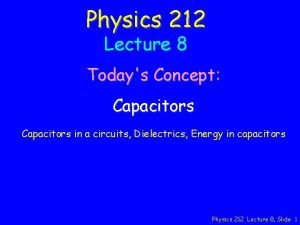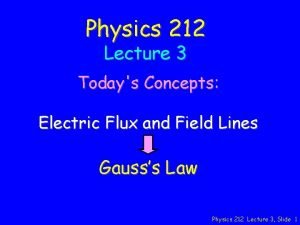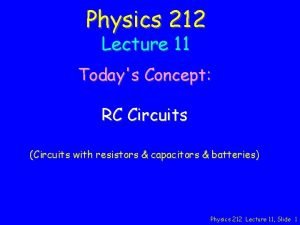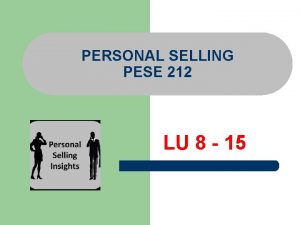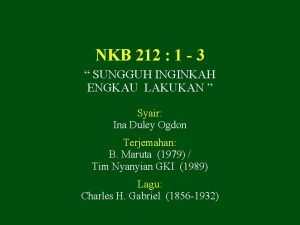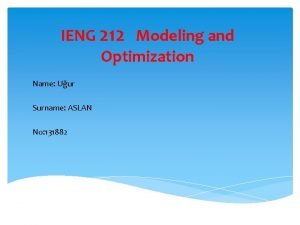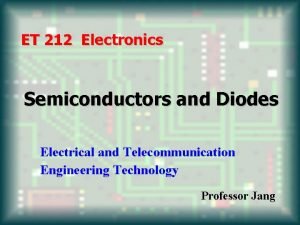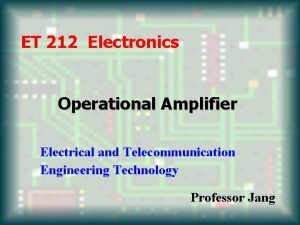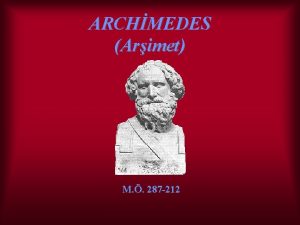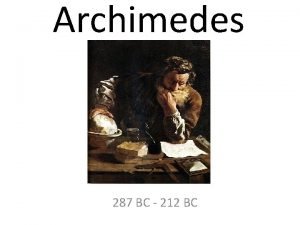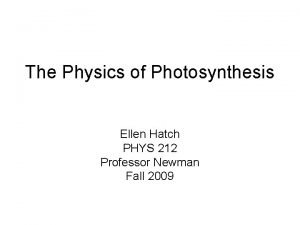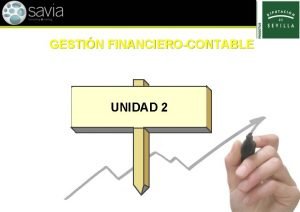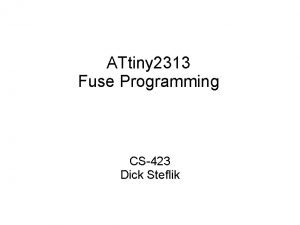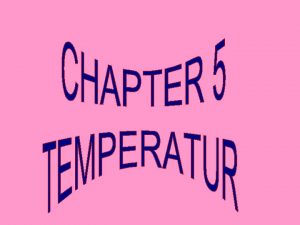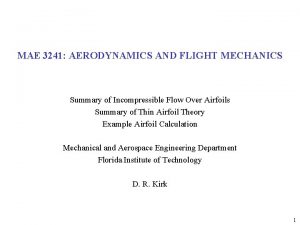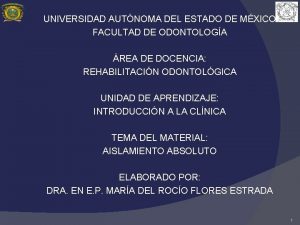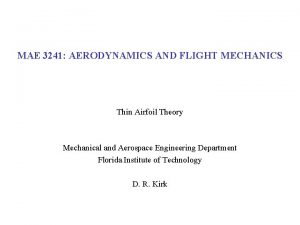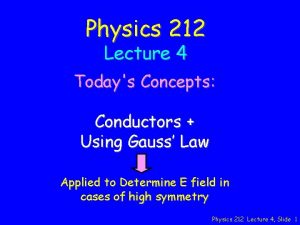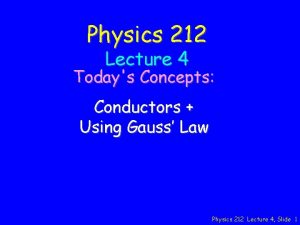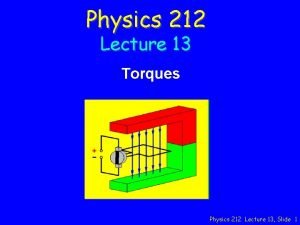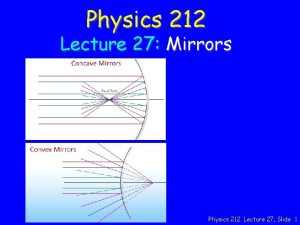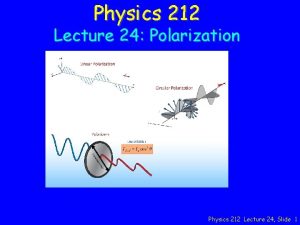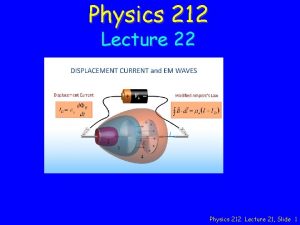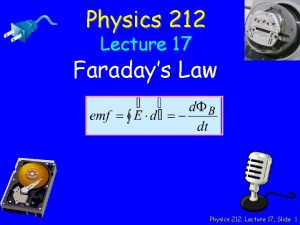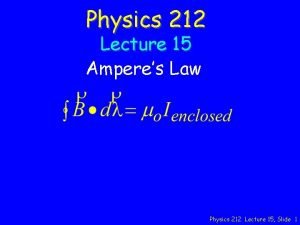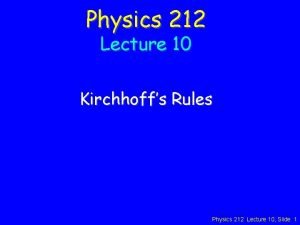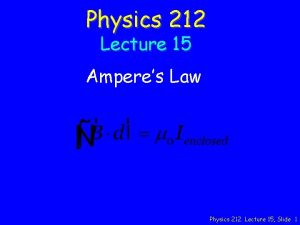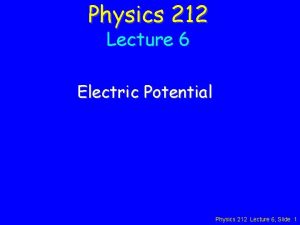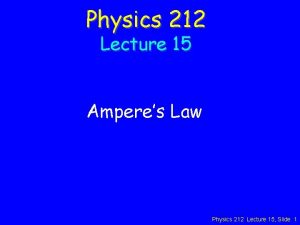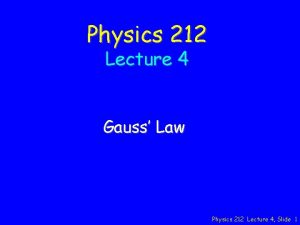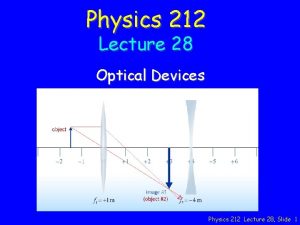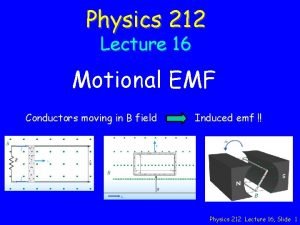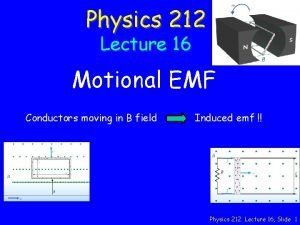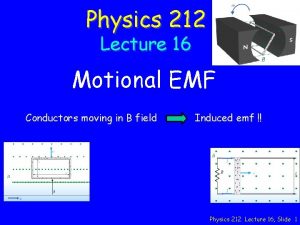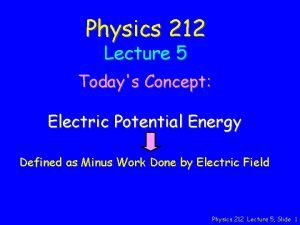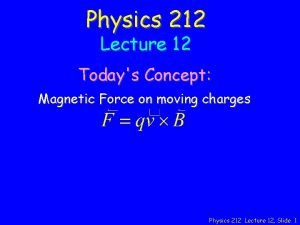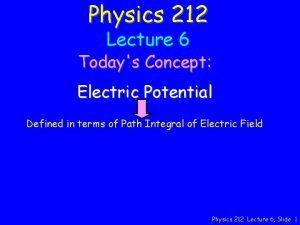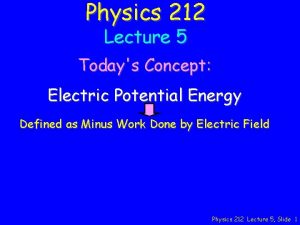Physics 212 Lecture 7 Todays Concept Conductors and



























- Slides: 27

Physics 212 Lecture 7 Today's Concept: Conductors and Capacitance Physics 212 Lecture 7, Slide 1

Music Who is the Artist? A) B) C) D) E) Eric Clapton Bill Frisell Jimmy Page Jeff Beck Buddy Guy Why? Starting on some circuits – electric guitar Physics 212 Lecture 3

LOGISTICS 1) EXAM 1: WED Feb. 15 at 7 pm Sign Up in Gradebook for Conflict Exam at 5: 15 pm if desired BY Mon. Feb. 13 at 10: 00 p. m. MATERIAL: Lectures 1 - 8 2) EXAM 1 PREPARATION? Old exams are on-line (“Practice Exams”), also “Worked Examples” and “Exam Prep Exercises” Physics 212 Lecture 7, Slide 3

Your Comments “I'm really lost. Can you explain the examples more in lecture please? ” “I enjoyed this lecture, seems pretty straight forward. ” “Soooooooooooooooooooo confused and the homework was sooooooooooooooooooooooooo hard” “How exactly does an electric field store energy in capacitors? ” “go over the conductor between the plates!” “PLEASE!!! EXPLAIN SOME OF THE HOMEWORK IN CLASS!!!” “I feel like all the examples were just derived from the prelecture, and I would like to go over some different examples to make sure I truly understand this stuff, and am not just repeating exactly what was previously told to me. ” True, but … We’ll go through the conductor between the plates for two separate cases We’ll do a problem much like a homework problem at the end of class 05 “If there is a train that could hold then entire capacity of students enrolled in Physics 212, that conductor must be pretty attracted to his job. ” “Ignorance is bliss” Physics 212 Lecture 7, Slide 4

Conductors You did well on the questions on charge distributions on conductors The Main Points • • 5 Charges free to move E = 0 in a conductor (even in a cavity) Surface = Equipotential E at surface perpendicular to surface Physics 212 Lecture 7, Slide 5

Checkpoint 1 a Two spherical conductors are separated by a large distance. They each carry the same positive charge Q. Conductor A has a larger radius than conductor B. Compare the potential at the surface of conductor A with the potential at the surface of conductor B. A. VA > VB B. VA = VB C. VA < VB “larger area more charge” “Conductors with the same charge are equipotential“ “The radius of A is 4 B, and since V=k. Q/r you get 4 Va=Vb” 6 Physics 212 Lecture 7, Slide 6

Checkpoint 1 b The two conductors are now connected by a wire. How do the potentials at the conductor surfaces compare now? A. VA > VB B. VA = VB C. VA < VB “No matter what the initial conditions are, when both spheres are making contact, their potential has to be equal since they are connected by a wire that makes them behave like a single conductor. ” 7 Physics 212 Lecture 7, Slide 7

Checkpoint 1 c What happens to the charge on conductor A after it is connected to conductor B by the wire? A. QA increases B. QA decreases C. QA doesn’t change “Charge will always move to a place with lower potential, and the larger sphere has a lower potential than the smaller sphere. ” “the charge would decrease in order to compensate for the lower charge on the particle B” “When you connect two conductors by a wire and charge moves between them as to make difference in potential of the system zero what is the charge of the wire? Or does it not matter? ” 8 Physics 212 Lecture 7, Slide 8

Parallel Plate Capacitor Two parallel plates of equal area carry equal and opposite charge Q 0. The potential difference between the two plates is measured to be V 0. An uncharged conducting plate (the green thing in the picture below) is slipped into the space between the plates without touching either one. The charge on the plates is adjusted to a new value Q 1 such that the potential difference between the plates remains the same. THE CAPACITOR QUESTIONS WERE TOUGH! THE PLAN: We’ll work through the example in the Prelecture and then do the Checkpoint questions. Physics 212 Lecture 7, Slide 9

Capacitance is defined for any pair of spatially separated conductors How do we understand this definition ? ? ? • Consider two conductors, one with excess charge = +Q and the other with excess charge = -Q +Q d E V -Q • These charges create an electric field in the space between them • We can integrate the electric field between them to find the potential difference between the conductors • This potential difference should be proportional to Q !! • The ratio of Q to the potential difference is the capacitance and only depends on the geometry of the conductors 9 Physics 212 Lecture 7, Slide 10

Example (done in Prelecture 7) First determine E field produced by charged conductors: What is s ? ? +Q y d x E -Q A = area of plate Second, integrate E to find the potential difference V As promised, V is proportional to Q !! st o m Al g n i th y er v e u yo ed e n HW r fo 1! C determined by geometry !! 12 Physics 212 Lecture 7, Slide 11

Question Related to Checkpoint 2 +Q 0 Initial charge on capacitor = Q 0 d -Q 0 Insert uncharged conductor Charge on capacitor now = Q 1 +Q 1 d t -Q 1 How is Q 1 related to Q 0 ? ? A. Q 1 < Q 0 B. Q 1 = Q 0 C. Q 1 > Q 0 14 Plates not connected to anything CHARGE CANNOT CHANGE !! Physics 212 Lecture 7, Slide 12

Where to Start? ? +Q 0 d t -Q 0 What is the total charge induced on the bottom surface of the conductor? A. B. C. D. E. 17 +Q 0 -Q 0 0 Positive but the magnitude unknown Negative but the magnitude unknown Physics 212 Lecture 7, Slide 13

WHY ? ? +Q 0 -Q 0 +Q 0 E E=0 E -Q 0 WHAT DO WE KNOW ? ? ? E must be = 0 in conductor !! Charges inside conductor move to cancel E field from top & bottom plates 19 Physics 212 Lecture 7, Slide 14

Calculate V Now calculate V as a function of distance from the bottom conductor +Q 0 y E d t y -E 0 d E=0 t V -Q 0 21 What is DV = V(d)? A) DV = E 0 d B) DV = E 0(d – t) C) DV = E 0(d + t) y The integral = area under the curve Physics 212 Lecture 7, Slide 15

Back to Checkpoint 2 a Two parallel plates of equal area carry equal and opposite charge Q 0. The potential difference between the two plates is measured to be V 0. An uncharged conducting plate (the green thing in the picture below) is slipped into the space between the plates without touching either one. The charge on the plates is adjusted to a new value Q 1 such that the potential difference between the plates remains the same. A) Q 1 < Qo B) Q 1 = Qo C) Q 1 > Qo “The air space in between Q 0 is greater than Q 1 so Q 0 must be greater to achieve the same potential difference. ” “The potential difference is just the difference in charge between the plates. Adding a conductor in the center doesn't change that” “Q 1 needs a greater charge to have the same potential since part of its electric field is zero. ” How do you get the same V in ‘less space’? Physics 212 Lecture 7, Slide 16

Checkpoint 2 b Two parallel plates of equal area carry equal and opposite charge Q 0. The potential difference between the two plates is measured to be V 0. An uncharged conducting plate (the green thing in the picture below) is slipped into the space between the plates without touching either one. The charge on the plates is adjusted to a new value Q 1 such that the potential difference between the plates remains the same. What happens to C 1 relative to C 0? A) C 1 > Co B) C 1 = Co C) C 1 < Co “Capacitance is directly proportional to the charge, so if in case 1, the charge is greater than in case 0, that means the Capacitance is greater. ” “Capacitance is equal to charge over voltage, both of which are the same. ” “C=(1/2)*((Q^2)/U). Thus, if Q decreases, then C will decrease. ” Physics 212 Lecture 7, Slide 17

Checkpoint 2 b Two parallel plates of equal area carry equal and opposite charge Q 0. The potential difference between the two plates is measured to be V 0. An uncharged conducting plate (the green thing in the picture below) is slipped into the space between the plates without touching either one. The charge on the plates is adjusted to a new value Q 1 such that the potential difference between the plates remains the same. What happens to C 1 relative to C 0? A) C 1 > Co B) C 1 = Co C) C 1 < Co We can determine C from either case same V (Checkpoint) same Q (Prelecture) C depends only on geometry !! Same V: V 0 = E 0 d V 0 = E 1(d – t) E = Q/e 0 A C 0 = Q 0/E 0 d C 1 = Q 1/(E 1(d – t)) C 0 = e 0 A/d C 1 = e 0 A/(d – t) Physics 212 Lecture 7, Slide 18

Energy in Capacitors BANG 31 Physics 212 Lecture 7, Slide 19

Homework for Lec. 7&8 Physics 212 Lecture 7, Slide 20

Calculation cross-section a 4 a 3 A capacitor is constructed from two conducting cylindrical shells of radii a 1, a 2, a 3, and a 4 and length L (L >> ai). a 2 a 1 What is the capacitance C of this device ? metal • Conceptual Analysis: But what is Q and what is V? They are not given? ? • Important Point: C is a property of the object!! (concentric cylinders here) • Assume some Q (i. e. , +Q on one conductor and –Q on the other) • These charges create E field in region between conductors • This E field determines a potential difference V between the conductors • V should be proportional to Q; the ratio Q/V is the capacitance. 33 Physics 212 Lecture 7, Slide 21

cross-section a 4 a 3 Calculation A capacitor is constructed from two conducting cylindrical shells of radii a 1, a 2, a 3, and a 4 and length L (L >> ai). a 2 a 1 metal What is the capacitance C of this capacitor ? metal • Strategic Analysis: – – Put +Q on outer shell and –Q on inner shell Cylindrical symmetry: Use Gauss’ Law to calculate E everywhere Integrate E to get V Take ratio Q/V: should get expression only using geometric parameters (ai, L) Physics 212 Lecture 7, Slide 22

Calculation cross-section +Q + + + -Q + + + a 2 a 1 + a 4 a 3 + metal + + A capacitor is constructed from two conducting cylindrical shells of radii a 1, a 2, a 3, and a 4 and length L (L >> ai). What is the capacitance C of this capacitor ? + + + metal Where is +Q on outer conductor located? (A) at r=a 4 (B) at r=a 3 (C) both surfaces (D) throughout shell Why? Gauss’ law: We know that E = 0 in conductor (between a 3 and a 4) +Q must be on inside surface (a 3), so that Qenclosed = + Q – Q = 0 Physics 212 Lecture 7, Slide 23

Calculation cross-section +Q + + - - - - + + - -Q - + + - - metal - + + + + a 2 a 1 + a 4 a 3 A capacitor is constructed from two conducting cylindrical shells of radii a 1, a 2, a 3, and a 4 and length L (L >> ai). What is the capacitance C of this capacitor ? metal Where is -Q on inner conductor located? (A) at r=a 2 (B) at r=a 1 (C) both surfaces (D) throughout shell Why? Gauss’ law: We know that E = 0 in conductor (between a 1 and a 2) +Q must be on outer surface (a 2), so that Qenclosed = 0 Physics 212 Lecture 7, Slide 24

Calculation cross-section +Q A capacitor is constructed from two conducting cylindrical shells of radii a 1, a 2, a 3, and a 4 and length L (L >> ai). What is the capacitance C of this capacitor ? + + - - - - + + - -Q - + + - - metal - + + + + a 2 a 1 + a 4 a 3 metal a 2 < r < a 3: What is E(r)? (A) 0 (B) (C) (D) (E) Why? Gauss’ law: Direction: Radially In Physics 212 Lecture 7, Slide 25

Calculation cross-section +Q + + - - - - + + - -Q - + + - - metal - + + + + a 2 a 1 + a 4 a 3 A capacitor is constructed from two conducting cylindrical shells of radii a 1, a 2, a 3, and a 4 and length L (L >> ai). What is the capacitance C of this capacitor ? a 2 < r < a 3: metal r < a 2: E(r) = 0 since Qenclosed = 0 Q (2 pe 0 a 2 L) • What is V? • The potential difference between the conductors What is the sign of V = Vouter - Vinner? (A) Vouter-Vinner < 0 (B) Vouter-Vinner = 0 (C) Vouter-Vinner > 0 Physics 212 Lecture 7, Slide 26

Calculation cross-section A capacitor is constructed from two conducting cylindrical shells of radii a 1, a 2, a 3, and a 4 and length L (L >> ai). What is the capacitance C of this capacitor ? +Q + + - - - - + a 2 a 1 + a 4 a 3 + - -Q - + + - - metal - + + + a 2 < r < a 3: + metal What is V Vouter - Vinner? (A) (B) (C) (D) Q (2 pe 0 a 2 L) V proportional to Q, as promised Physics 212 Lecture 7, Slide 27
 Physics 212 gradebook
Physics 212 gradebook Physics 212 gradebook
Physics 212 gradebook Todays concept
Todays concept 01:640:244 lecture notes - lecture 15: plat, idah, farad
01:640:244 lecture notes - lecture 15: plat, idah, farad Classical mechanics
Classical mechanics Physics 101 lecture notes pdf
Physics 101 lecture notes pdf Phy101 lecture 1
Phy101 lecture 1 Physics 101 lecture notes pdf
Physics 101 lecture notes pdf Notes on waves physics pdf
Notes on waves physics pdf Atmospheric physics lecture notes
Atmospheric physics lecture notes Pese 212
Pese 212 Nkb 212
Nkb 212 Ienf 212
Ienf 212 Et 212
Et 212 Et 212
Et 212 Arm reach 212 cm on tiptoes
Arm reach 212 cm on tiptoes Archimedes ( arşimet) (mö 287–212 )
Archimedes ( arşimet) (mö 287–212 ) 212 bc
212 bc Phys 212 equation sheet
Phys 212 equation sheet 212 instalaciones tecnicas ejemplos
212 instalaciones tecnicas ejemplos Attiny 212
Attiny 212 Có 3 thùng dầu mỗi thùng chứa 125l tóm tắt
Có 3 thùng dầu mỗi thùng chứa 125l tóm tắt Hubungan antara suhu dan pemuaian benda
Hubungan antara suhu dan pemuaian benda Naca 2412
Naca 2412 Tipos de dique de hule
Tipos de dique de hule Cls 212
Cls 212 Maximum lift coefficient formula
Maximum lift coefficient formula Cls 212
Cls 212
